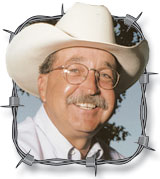Bud (not his real name) is not unlike most farmers I know. As soon as he purchases a new piece of equipment, he has to try it out absolutely as soon as possible. Such was the case last week when the machinery dealer delivered a new, hydraulic, bale unroller for his tractor.
The young farmer had been feeding in bale rings for the past few years, but he had recently purchased more land and more cattle, and had decided that unrolling the round bales would allow the cows better access to the hay. As an added bonus, the young calves would have a warmer and dryer place to lie during the cold of winter. As soon as he got home from his day job, he immediately attached the implement to his tractor and was off to the bale yard, located at the other end of his quarter-mile long, fenced and manicured driveway.
The new device worked just like the salesman had described, as he squeezed the 1,200-pound bale, raised it with the flip of a lever, removed the net wrap from the bale, and proceeded to the pasture where his cattle waited. Used to gathering in a circle around the bale ring, they were a little confused as he drove past the empty ring and lowered the hydraulic arms (again, with one flip of the lever) to gently unroll the giant hay bale. The curious cows sauntered over to inspect his job and must have approved as they began to devour the leafy forage. Even the calves seemed to endorse the farmer’s new purchase, as evidenced by a few of the younger ones immediately lying on the soft, new bed.
Bud was pleased with the performance of his new tool, even though his wife had been a little reluctant about the purchase, and he took pride in watching the response of both the cows and their calves. He even considered unrolling a second bale that afternoon, just for the fun of it, but decided that would just be a waste of good hay. He would, however, go ahead and load another one onto the unroller so it would be ready to go the next afternoon when he got home from work.
At the bale yard, he loaded a second bale and proceeded to go ahead and remove the net wrap before heading down the driveway to his machinery barn. Bud takes meticulous care of his equipment and always keeps the tractor in the barn, protected from the elements, and plugs into electricity to make the diesel engine easier to start during the winter. Knowing he now had a bale on the back of his tractor, he was extra-careful as he backed into the parking place, making sure he didn’t hit the wall where he normally parks. Everything was good as he plugged in the tractor, lowered the overhead door, and headed in for supper with the family.
The next afternoon, Bud couldn’t wait to get home to use his new implement once more. Upon arrival, he raised the door, unplugged the tractor, started it, and headed down the driveway to the pasture entrance. When he stopped to open the gate, he looked back toward his house and realized that the lift had leaked down during the previous 24 hours, and he had unrolled (perfectly, I might add) about 200 yards of hay from the machinery barn to the gate.
Since putting unrolled hay back into a movable form is just about as easy as putting toothpaste back in the tube, Bud called me wanting to borrow a pitchfork and a leaf blower.
“I understand the pitchfork, but why do you need a leaf blower?” I asked.
“My wife will be home in two hours. I need to get rid of all the evidence.”







